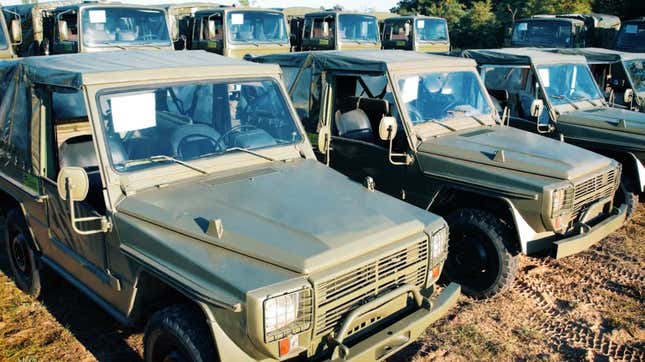Here's How The G-Wagen's Ancient French Cousin Ended Up On The Front Lines In Ukraine

While poking around on Instagram I found a picture of what looked like a drab green military-spec Mercedes-Benz G-Class that had been recently delivered to the forces fighting on the front lines of Ukraine. The @future_Ukraine account labeled the vehicle in question not as the much-beloved Mercedes Geländewagen, instead it was called out as a Peugeot P4. The P4 was a license-built French version of the beloved German utility vehicle constructed entirely of 90-degree angles on wheels.
The Toyota Land Cruiser Is Back Baby!
Even though the Mercedes G-Wagen has strayed from its military roots to become the ultimate status symbol propelled by Hollywood and the Kardashians, Mercedes does indeed still make a modern version for military operations. It’s called the 464 G-Class Utility Truck and it’s for non-civilian use only. Pricing information for a 464 isn’t publicly shared, but the closest civilian counterpart, the W463 G400d, is north of $150,000. With a strained defense budget, Ukraine isn’t spending that kind of dough on light utility vehicles that will likely meet their end on the battlefield.
Image: Militarnyi
That’s where the aged Peugeot P4 comes in. It’s the perfect vehicle for the job because it was specifically engineered for military duty in the early ‘80s and is well-suited for the kind of hybrid warfare happening on the front line. The French military phased out its use of the P4 back in 2016, and examples can be found on the surplus market, mostly in France, for roughly $10,000. That ten grand buys a reconditioned Pug P4 ready to get back to duty. It neatly fits Ukraine’s material and equipment requirements in the war against Russia. Those fighting for their freedom need something cheap, produced in relatively high volumes, easy to source and supply through non-state agencies (countries directly supplying Ukraine with military aid and equipment can be sensitive), and most importantly, capable.
The P4 has long served the French military both in France and its overseas territories. Nations bound to France through defense agreements also operated the P4, and the reason it hasn’t gained a cult following in car-nerd circles like the Toyota Mega Cruiser or Suzuki Jimny is because it was never allowed to be exported to any other country than the ones tied to the military of France. Outside these nations the light utility vehicle is virtually unheard of. Until 2016, that is. It was then that a good chunk of P4 models were donated to Cameroon’s forces and the rest ended up on the surplus circuit and you can always find good examples in specialty sales lots like Lys Tout Terrain, for example.

Image: Militarnyi
In the late ‘60s, the French military had established that their fleet of Willys Jeeps leftover from the WWII days would soon be obsolete. As the role called for a light utility vehicle, it needed to meet the payload requirements to be transported by air to various French bases and conflict zones. It also needed to carry four soldiers with radio and standard military equipment. Most importantly, it needed to be French-built. The only problem was that the 4×4 market in France at the time was not very robust, with few manufacturers producing a capable platform that would meet the needs of the French military. Citroën, Peugeot, and Renault were tasked with finding a solution, and in order to meet the criteria, Renault turned to their partner, Fiat, to homologate the Campagnola to meet the French-made requirements. Citroën came up with the C44, which was a Volkswagen Iltis with a French powerplant.
But it was the Peugoet P4 that eventually won the military bid. The P4 was a G-Class with the engine from a Peugeot 504 and the transmission from a 604. Peugeot also welded the truck up, installed the electrical systems, and painted the trucks at their Sochaux plant. The testing phase began in 1978, and by 1981 the first round of P4 examples were delivered. Then in 1985, truck maker Panhard took over production to carry out the remaining orders.

Image: Wikimedia
These vehicles served until 2016, and now some of them are living a second life in the Russo-Ukranian War. ORYX maintains an unofficial inventory of the military vehicles delivered to Ukraine, of which the P4 appears. According to the Ukranian military blog Militarnyi, military operating out of the Dnipro Defense Headquarters directly purchased additional Peugeot P4 models beyond the NGO-supplied examples.
Many of these trucks never saw combat during their time in service, hence they remained in ideal condition. Almost a decade after they were retired from the French military, they continue to serve–albeit in a much different capacity—in Ukrainian hands.







